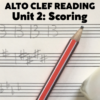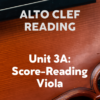Use extreme caution when applying extreme dynamics, and be aware of the physical realities and limitations for your players; not to mention issues of comparative balance.
Extreme dynamics have become ever more common in the modern era, and are often used in scores without any systematic application. Composers will drop in a pppp right after an ffff, and then realise with some shock at the rehearsal that the players sound inaudible, or have problems maintaining a workable embouchure. Or they’ll just keep adding f’s or p’s to their markings, hoping to continue to amp up or tone down a passage of music.
To an extent, then, extreme dynamics can represent a kind of idealism of expression that’s often unworkable. This goes all the way back to Tchaikovsky, who famously set a trap for bassoonists in scoring a clarinet solo in the first movement of his 6th Symphony, in which he keeps softening their line with one additional p marking after another, until the soloist has gotten all the way down to a quintuple ppppp – the equivalent of a subtone or niente. As the line drops, he asks the bassoonist to complete the solo with four more downward-dipping notes at the same dynamic – more or less impossible for their instrument. at least in terms of matching the clarinetist’s extreme delicacy of tone and restraint. This hasn’t prevented bassoonists from trying to get their dynamics down to that ultra-fine point, though, and it’s intriguing to hear their efforts in various historic recordings. But more recently, those last few notes are usually given over to a bass clarinetist, with far greater control over the extremely soft dynamics asked for in the score. As the unique qualities of timbre become somewhat ambiguous at such a barely-audible level, the compromise seems justified to a lot of conductors (and audiences). As it’s unlikely that the orchestra would hire an additional player just to cover four notes for the entire symphony, the 2nd clarinetist substitutes for the bassoonist on their bass clarinet. But there’s a tradeoff – the next passage is intended to leap suddenly upon the last breath of their solo – leaving the player no time to change back to their standard clarinet. But since their first note is doubled by first trumpet and 2nd violins, and the rest of their notes are covered by the 4th horn and violas up to the middle of the 4th bar, they have a little bit of time in which to put down their bass clarinet and pick up their A.
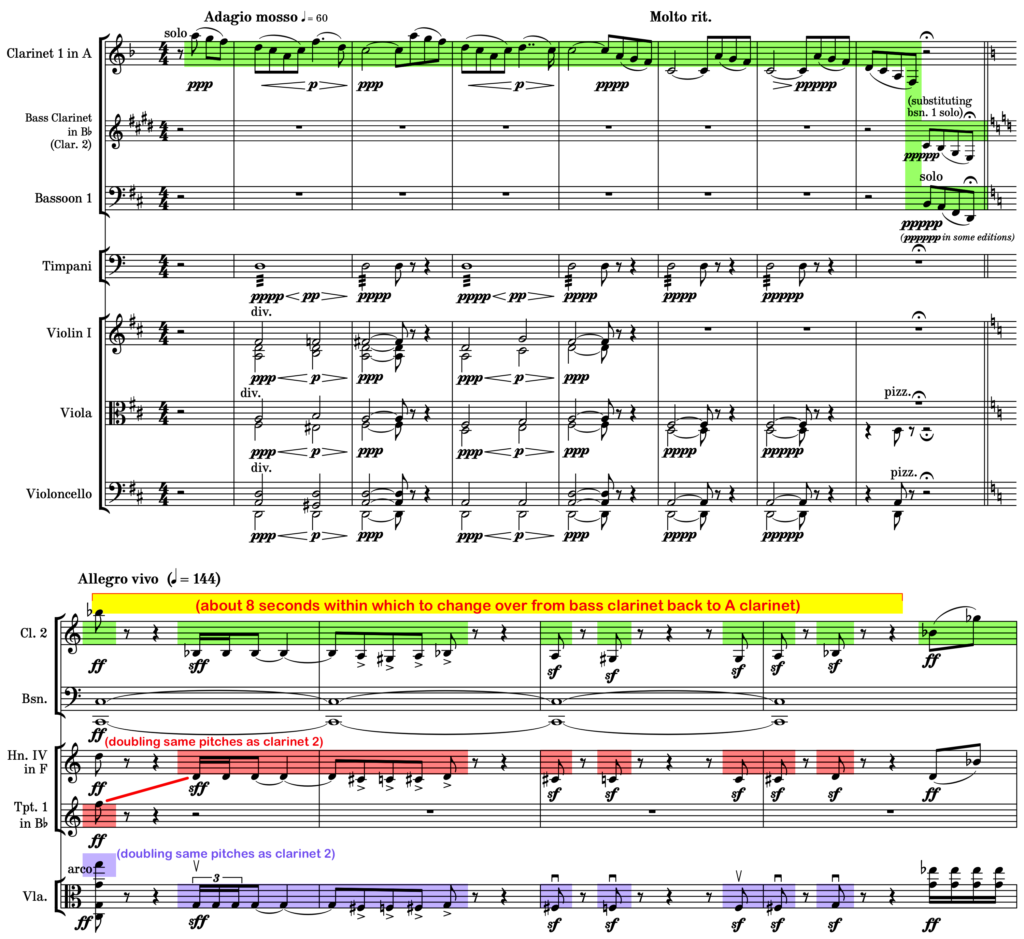
I often rail against the casual use of niente fadeouts in concert scores being used all over the place for all instruments – as if it were a simple proposition for every wind and brass instrument to smoothly bring down their dynamics to nothing with equal efficiency at the whim of the orchestrator, or to fade in from nothing. Usually, all that’s needed is a simple hairpin leading to or from a ppp marking. That’s the best a score will get in a lot of cases, and usually what a developing orchestrator really intends in the first place – so why not just use it?

As I’ve already pointed out in my chapter about niente in 100 Orchestration Tips, the purpose of a niente dynamic should always be to call attention to itself as an effect that really forces the audience to notice it. It should never be used to just soften down and fade out while something much more interesting is going in other parts. All that you achieve with the latter approach in your scoring is a wasted effort by the players, and perhaps an internal shrug or eyeroll from them.
The worst misuse is to tag the ending of every note of a solo or the end of every passage with a niente hairpin – seemingly unaware that orchestral players normally shape their articulation to avoid an abrupt, cut-off ending to their notes (unless asked to play staccato or tenuto). It’s unnecessary to fill a player’s life with niente fadeouts. Even if it were easy to achieve for everyone, most of these fadeouts would be wasted against other ongoing parts, or ultimately sound precious and over-finessed.
While that kind of scoring is simply annoying or at the worst misleading, some super-soft markings can actually be exhausting and potentially harmful. For instance, a very long, high ppp or pppp passage on horn tires out the player, with the added risk that they may fall off a long held note. There are also upper and lower limits to extremely soft dynamics. A general rule of thumb (with some exceptions): extremes of range don’t necessarily mix with extremes of soft dynamics; pppp in the altissimo register of woodwinds and brass especially – but also extreme low notes in double reeds and brass can be hard to control down to the finest of whispers. However, flute and clarinet family members can control these low notes with ease, as can saxophones playing subtones.
One last point about extremely soft dynamics worth discussing is the balance of elements. The orchestrator must take into account natural tone-weight, timbre and articulation when setting one line against another. Once again, a certain level of idealism often creeps into even the greatest composers’ works. In the following passage from Berlioz’s Symphonie Fantastique, the scoring fades certain elements down to extremely soft dynamics: the violins down from ppp to “presque rien” (“next to nothing,” essentially niente), with similarly marked pp pizzicato lower string parts. It’s doubtful that a strict observation of all these markings would truly balance the passage – and some internal adjustments tend to be made in the interpretation by musicians. If the violins truly did fade away to the very edge of audibility at bar 345, the harmonic context of the viola and cello pizzicati would be lessened. Certainly the ppp a4 bassoons at Reh. D1 would completely smother the very important pppp double bass entrance below them.
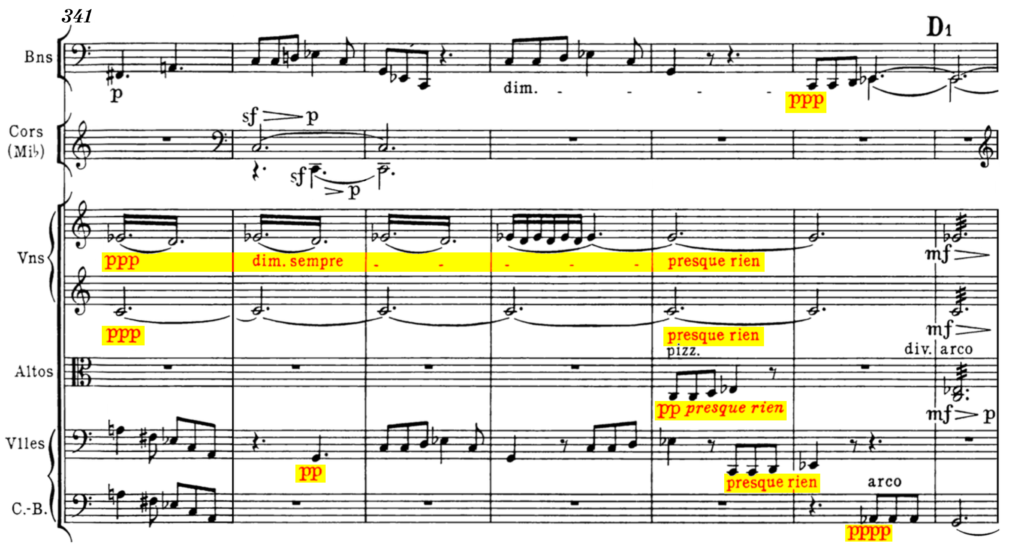
But what of extremely loud dynamics? Throughout the 19th century, at least, fff was used fairly freely in the works of more ambitious composers from Berlioz forward – but by the late Romantic era, ffff started to make its appearance, notching up from fff in certain passages. Not always as the final climactic marking, though; in the third movement of Tchaikovsky’s 6th Symphony, 6 bars after Reh. HH, he pushes the whole orchestra up to a quadruple ffff to drive home the end of an episode. But afterwards, he drops everyone down to p and then finishes the movement with half a dozen pages at fff.
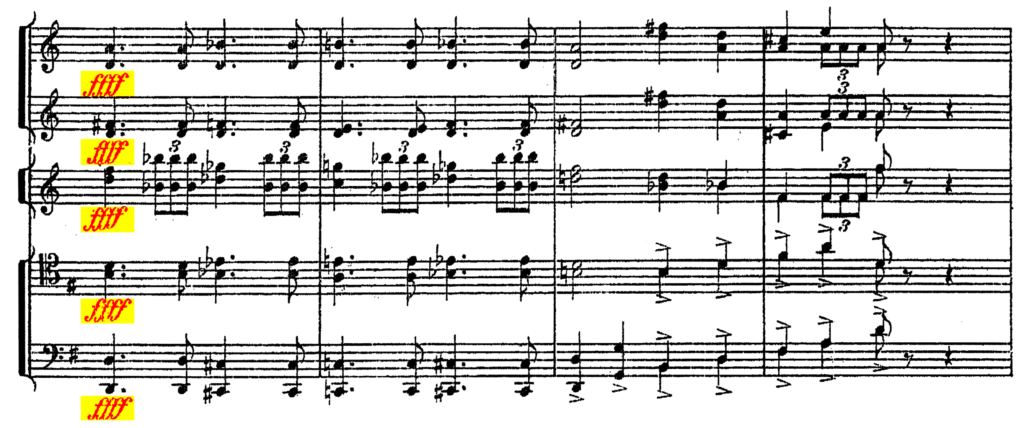
From this point onwards, especially in massive 20th century scoring, ffff became more common, often as a way of accenting or emphasising certain elements in a passage of fff – especially as the final stroke of a loud piece. Still, it’s worth mentioning that in a lot sprawling masterpieces of that era, some composers avoided marking much higher than a simple ff, and treated fff as the absolute limit. Ravel’s Daphnis et Chloé comes to mind, as do some works by Mahler and Strauss.
There’s an important consideration here as well – does the marking represent an orchestral dynamic? Or what some players might call a “personal dynamic”? In other words, can some louder players like the brass and percussion treat an extremely loud marking as more of an overall dynamic for the cumulative sound of the orchestra? In which case, if they’re already playing near the limit of their dynamic range, there’s no need push it up to the point of ridiculousness. In such cases, the conductor might provide some guidance in sifting the proportions for the players. Or they might insist that the players really go to the very limit of what’s possible – in which case, the marking would be “personal” – relevant to the capabilities of their instruments.
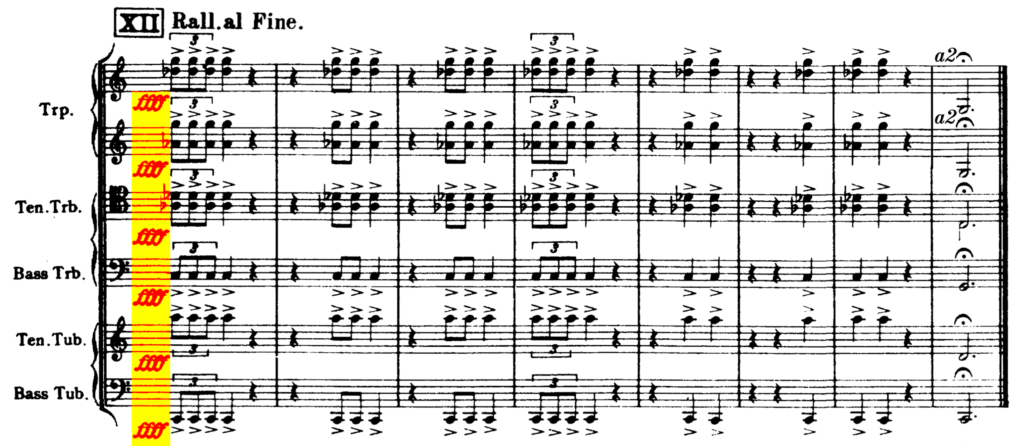
Interpretively, if the music constantly rebounds between ff, fff, and ffff, or adds on one f after another and another and another, there’s a risk that after awhile the players will just start to ignore the markings – not simply out of exasperation, but because there’s nothing more to be done. No greater sound may be meaningful or possible if the orchestrator is running out the limits of playability in a passage. And then the risk is that dynamics like f-to-ff might end up proportionally weaker, more like mf-to-f, if the score is establishing fff and ffff as norms for maximal impact.
Of course, the limitations abound, especially for those players in the orchestra notorious for strength and projection. Playing brass instruments requires a great deal of physical commitment in louder passages, and such strength isn’t an endless tap that can be turned on and off at the orchestrator’s whim. The louder the markings, the quicker the player’s resources of endurance are exhausted, especially with regard to embouchure. This may, in turn, require that over-the-top markings that go on for dozens of pages be tempered a bit in their forcefulness, simply so the players can make it to the end of the piece. While string players are able to maintain extremely loud playing a bit easier for longer stretches, their arms will eventually tire after row upon row of marcato accents or all downbows. The most tiring string technique is extremely loud unmeasured tremolo, which can potentially injure to the player’s arm muscles after long passages.
Especially to be avoided: super-loud cuivré playing in the horns. As the effect is achieved by a thinning of the lips, extended passages of cuivré at fff and ffff might actually tear the muscles, ending a player’s usefulness for the rest of the concert if not their whole career. An experienced hornist would probably refuse to put themselves at risk anyway, and might just play such a passage with a more boisterous sound. But it probably wouldn’t be the cuivré you’re imagining, like the Siegfried horn call (which peaks at a perfectly effective fortissimo, and doesn’t stay there for too long).
But what about contrasting between super-loud and super-soft dynamics? For some instruments like percussion and strings, sudden shifts from loudest to softest are fairly easy. But for winds and especially brass, such markings are problematic. Imagine practicing with a punching bag at full force for several minutes, and then trying to script the most delicate, fine calligraphy. Then you’ll begin to understand the challenge faced by a brass player screaming out a ffff, and then suddenly dropping down to a soft note (especially if it’s a high note) – all while being completely exposed, with nowhere to hide if their lips crack. This only strengthens the argument for having a bumper cover the first horn part, when the composers are less forgiving in their scoring.

Carl Sagan had a saying that’s often quoted in today’s age of misinformation: “Extraordinary claims require extraordinary proof.” In the same vein, extreme dynamics require an extreme level of care when scoring. Really educate yourself as an orchestrator when asking pppp or ffff from your players – in the sound of their instruments, the technical and physical limitations, and the previous uses of those markings in the repertoire.
But what should you do in your own scoring? What are some safe limits for the developing orchestrator, often working with community and semipro orchestras at first? Is there a philosophy or a set of ground rules by which a composer might safely explore and utilise extreme dynamics? I hope to answer all those questions and more in my followup tip, “Extreme Dynamics, Part II: A Systematic Approach.”




